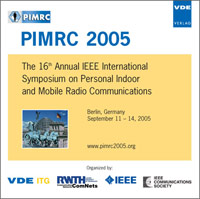Uplink Pre-Equalization Using MMSE Prediction for TDD/MC-CDMA Systems
Konferenz: PIMRC 2005 - 16th Annual IEEE International Symposium on Personal Indoor and Mobile Radio Communications
11.09.2005 - 14.09.2005 in Berlin, Germany
Tagungsband: PIMRC 2005
Seiten: 5Sprache: EnglischTyp: PDF
Persönliche VDE-Mitglieder erhalten auf diesen Artikel 10% Rabatt
Autoren:
Takei, Yoshikazu (Department of Electrical Engineering, Tokyo University of Science, 2641 Yamazaki, Noda, Chiba 278-8510 Japan)
Ohtsuki, Tomoaki (Department of Information and Computer Science, Keio University, 3-14-1, Hiyoshi, Kohoku-ku, Yokohama, 223-8522, Japan)
Inhalt:
Recently, multi-carrier code-division multiple-access (MC-CDMA) has attracted much attention. To make smoothly connection with a base station (BS), time division duplex (TDD) systems using the reciprocity of uplink and downlink in the same frequency band is considered. If the coherence time is large compared with the duplexing time, TDD systems can provide the channel characteristics of uplink from that of downlink. Thus, the channel distortion can be compensated in advance as a pre-equalization at mobile terminals (MTs). The pre-equalization technique using zero-forcing equalization (ZFE) was proposed for the TDD/MC-CDMA system. The channel parameters obtained from the last pilot (LP) symbol in the downlink frame have the highest time correlations with the uplink channel parameters. Therefore, they can be used as the channel parameters of all the symbols in the following frame. However, when the coherence time is not so large compared with the duplexing time, it is expected that the system suffers from the channel mismatch by time-selective fading. In this paper, we propose a pre-equalization using MMSE channel prediction for TDD/MC-CDMA. As a derivation of the pre-equalization coefficients, we employ ZFE, Controlled Equalization (CE), and Minimum Mean Square Error Equalization (MMSEE). Simulation results show that the proposed channel prediction techniques are effective on time-selective fading channels.


